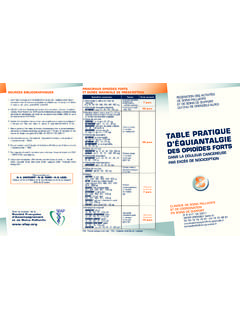Transcription of Pharmacology for Nurses: Basic Principles
1 Marinini/ShutterStock, IPharmacology for Nurses: Basic 108/09/14 9:43 am Jones & Bartlett Learning, LLC. NOT FOR SALE OR DISTRIBUTION. marinini/ShutterStock, 208/09/14 9:43 am Jones & Bartlett Learning, LLC. NOT FOR SALE OR to Pharmacology Jean Nicholas KEY TERMS Assessment Controlled substances Drug classifications Drug names Goals Medication errors Nursing diagnoses Nursing process Pharmacology Prescription drugs CHAPTER OBJECTIVES At the end of the chapter, the student will be able to: 1.
2 Explain what Pharmacology is. 2. Discuss how drugs are classified. 3. Differentiate what brand versus generic drug names are. 4. List the five steps of the nursing process. 5. Identify categories of controlled substances. 6. Name two sources for obtaining drug information. 7. Discuss legal and ethical responsibilities of the nurse . 8. Define medication error . CHAPTER 1 adistockShutterStock, 308/09/14 9:43 am Jones & Bartlett Learning, LLC. NOT FOR SALE OR modern health care, there is an increasing reliance on medication therapy to manage illness and disease, to slow progression of disease, and to improve patient outcomes.
3 Medications offer a variety of potential benefits to the patient: relief of symptoms, support for necessary physiological processes, and destruction of toxic substances or organisms that cause disease, to name a few. Yet medications also have the potential to do harm, even when administered properly and the harm is likely to be exacerbated if they are administered the persons most often charged with administer-ing medications to patients, nurses can minimize any harm associated with medications by carry-ing out this task with few, if any, errors (Institute of Medicine [IOM], 2007).
4 A 2007 IOM report on med-ication safety, titled Preventing Medication Errors, emphasized the urgency of reducing medication errors, improving communication with patients, continually monitoring for medication errors, pro-viding clinicians with decision-support and infor-mation tools, and improving and standardizing medication labeling and drug-related information (IOM, 2007).If one of nursing s primary roles is the safe administration of medications, it is important to realize that this requires knowing not only how to correctly administer medications to patients, but also how to determine whether the intended effects are achieved and whether any adverse, or unin-tended, effects have occurred.
5 Without adequate understanding of drugs and their effects on the body, nurses are unable to meet their professional and legal responsibilities to their patients. This text will provide you with that and PharmacologyPharmacology is the study of the actions of drugs, incorporating knowledge from other interrelated sciences, such as pharmacokinetics and pharmaco-dynamics. Knowledge from the various pharmaco-logic classes enables the nurse to understand how drugs work in the body, to achieve the therapeutic (intended) effects, and to anticipate and recognize the potential side effects (unintended or unavoid-able) or value of this knowledge in nursing cannot be overemphasized.
6 The nurse s role as caretaker puts the nurse in the position of being closest to the patient and best able to assess both the patient s condition prior to use of medication as well as the patient s response to the medication two key com-ponents of appropriate medical therapy. Clearly, under these circumstances, it is ideal for the nurse to have a solid, in-depth understanding of when, how, and for whom medications are best used, and what the expected response is when specific pharmaceuti-cal therapies are CHAPTER 1 Introduction to 408/09/14 9:43 am Jones & Bartlett Learning, LLC.
7 NOT FOR SALE OR the most Basic level, nurses must learn the various diagnostic and therapeutic classes of medi-cations; recognize individual drug names, both trade and generic; know about the applications and avail-ability of prescription and nonprescription medica-tions, and particularly the restrictions regarding controlled substances; and be familiar with sources, both printed and online, where the nurse may obtain specific information about particular drugs, includ-ing dosage, interactions, and CLASSIFICATI O N SDrugs are classified by how they affect certain body systems, such as bronchodilators uses for respiratory conditions; by their therapeutic use, such as antin-ausea; or based on their chemical characteristics, such as beta blockers.
8 Many may fit into more than one drug classification due to the various effects that they exert in the body. Because certain drugs in the same class have many features in common, cat-egorizing them in these ways helps nurses become familiar with many of the drugs they are adminis-tering. For example, there are many types of angio-tensin converting enzyme inhibitors, but they have many common side NAMESN urses must know both the trade name of a drug, which is assigned by the pharmaceutical company that manufactures the drug, and the generic name, which is the official drug name and is not protected by trademark.
9 Manufacturers may receive a patent on a new drug, which means that no other compa-nies can produce the drug until the patent expires. Once this patent has expired, other companies may manufacture the drug with a different trade name but equivalent chemical makeup. Some companies choose to use the generic name only for example, lisinopril (Prinivil) is now manufactured by many different drug companies. Generic names are not may be prescribed and dispensed by either trade name or generic name, as generic drugs are considered equivalent in most cases.
10 Generic drugs are typically less expensive than trade-name AND NONPRESCRIPTION DRUGSIn the United States, consumers have two ways to legally access drugs. One is to obtain a prescrip-tion for the drug from a licensed provider, such as a physician, dentist, or nurse practitioner; the other is to purchase drugs that do not require a prescrip-tion on an over-the-counter (OTC) basis. Some drugs previously available only by prescription have now become available OTC. Thus, it is essential for the nurse to gather information about the patient s use of both prescription drugs and OTC medications, as some combinations of both types of drugs can affect the actions and toxicities of either.











